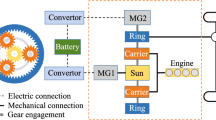Abstract
This paper investigates the minimal-energy driving problem for high-speed electric train, and then proposes a three-stage optimal strategy. First, a switching system model is introduced to describe the new dynamics in high-speed electric train, which considers the extended range of speed, the energy efficiency and the regenerative brake. Based on the new model, the optimal driving strategy with minimal-energy consumption is studied, and the problem is boiled down to optimal control for switching systems. Using a numerical algorithm, a three-stage driving strategy is concluded, in which the traditional quasi-coasting stage is discarded and the maximal traction and brake are not suitable anymore. Finally, a case study on CRH is illustrated.
Similar content being viewed by others
References
I. P. Milroy. Aspects of Automatic Train Control. Leicestershire, UK, 1990.
I. A. Asnis, A. V. Dmitruk, N. P. Osmolovshii. Solution of the problem of the energetically optimal control of the motion of a train by the maximum principle. USSR Computational Mathematics and Mathematical Physics, 1985, 25(6): 37–44.
P. G. Howlett. Optimal strategies for the control of a train. Automatica, 1996, 32(4): 519–532.
P. G. Howlett, I. P. Milroy, P. J. Pudney. Energy-efficient train control. Control Engineering Practice, 1994, 2(2): 193–200.
P. G. Howlett. The optimal control of a train. Annals of Operations Research, 2000, 98(1/4): 65–87.
P. G. Howlett, J. Cheng. Optimal driving strateges for a train on track with continuously varying gradient. Australian Mathematical Society, Series B, 1997, 38(3): 388–410.
X. Vu. Analysis of necessary conditions for the optimal control of a train. University of South Australia, Australia, 2006.
P. G. Howlett, P. J. Pudney, X. Vu. Local energy minimization in optimal train control. Automatica, 2009, 45(11): 2692–2698.
P. Lukaszewicz. Energy-saving driving methods for freight train. Computers in Railways IX, Dresden, Germany, 2004: 901–909.
Y. V. Bocharnikov, A. M. Tobias, C. Roberts, et al. Optimal driving strategy for traction energy saving on DC suburban railways. IET Electrical Power Applications, 2007, 1(5): 675–682.
General definitions of highspeed. International Union of Railways. http://www.uic.org/spip.php?article971 .
Z. Rahman, M. Ehsani, K. L. Butler. An investigation of electric motor drive characteristics for EV and HEV propulsion systems. SAE, DOI: 10.4271/2000-01-3062.
M. Ogasa. Energy saving and environmental measures in railway technologies: example with hybrid electric railway vehicles. IEEJ Transactions on Electrical and Electronic Engineering, 2010, 5(3): 304–311.
J. Faiz, M. B. B. Sharifian. Optimal design of an induction motor for an electric vehicle. European Transactions on Electrical Power, 2006, 16(1): 15–33.
N. Iwai. Analysis on fuel economy and advanced systems of hybrid vehicles. JEAE Review, 1999, 20(1): 3–11.
W. J. Davis. The tractive resistance of electric locomotives and cars. GE Review, 1926, 29(1): 685–707.
X. Xu, P. J. Antsaklis. Optimal control of switched systems. Proceedings of the 41th IEEE Conference on Decision and Control. Las Vegas, NV, 2002, 4: 4401–4406.
X. Xu, P. J. Antsaklis. Optimal control of switching systems based on parameterization of the switching instants. IEEE Transactions on Automatic Control, 2004, 49(1): 2–16.
S. C. Bengea, R. A. DeCarlo. Optimal control of switching systems. Automatica, 2005, 41(1): 11–27.
Author information
Authors and Affiliations
Corresponding author
Additional information
This work was supported by the National Key Technology R&D Program (No. 2009BAG12A08), the Research Foundation of the Ministry of Railways and Tsinghua University (RFMOR&THU) (Nos. 2009X003, J2009Z028), and the Research Foundation of Beijing National Railway Research Foundation of Beijing National Railway Research and Design Institute of Signal and Communication.
Liang LI received his B.S. degree from Xi’an Jiaotong University in 2007. He is currently a Ph.D. candidate in Tsinghua University. His research interests include optimal control and estimation theory of hybrid systems.
Wei DONG received his B.S. degree and Ph.D. degree from Tsinghua University in 2000 and 2006, respectively. He is currently an assistant researcher in the Department of Automation, and Tsinghua National Laboratory for Information Science and Technology, Tsinghua University. His research interests include fault diagnosis, modeling and simulation of complex system.
Yindong JI received his B.E. and M.S. degrees from the Department of Automation, Tsinghua University, in 1985, and in 1989, respectively. He is currently a professor of the Department of Automation, and Vice Dean of the Research Institute of Information Technology (RIIT), Tsinghua University. His main research areas are digital signal process, fault diagnosis. His current research interest is in the area of train control system of high speed railway.
Zengke ZHANG is a professor of Department of Automation, Tsinghua University. His research interests include motion control and intelligent control.
Rights and permissions
About this article
Cite this article
Li, L., Dong, W., Ji, Y. et al. A minimal-energy driving strategy for high-speed electric train. J. Control Theory Appl. 10, 280–286 (2012). https://doi.org/10.1007/s11768-012-1129-0
Received:
Revised:
Published:
Issue Date:
DOI: https://doi.org/10.1007/s11768-012-1129-0




